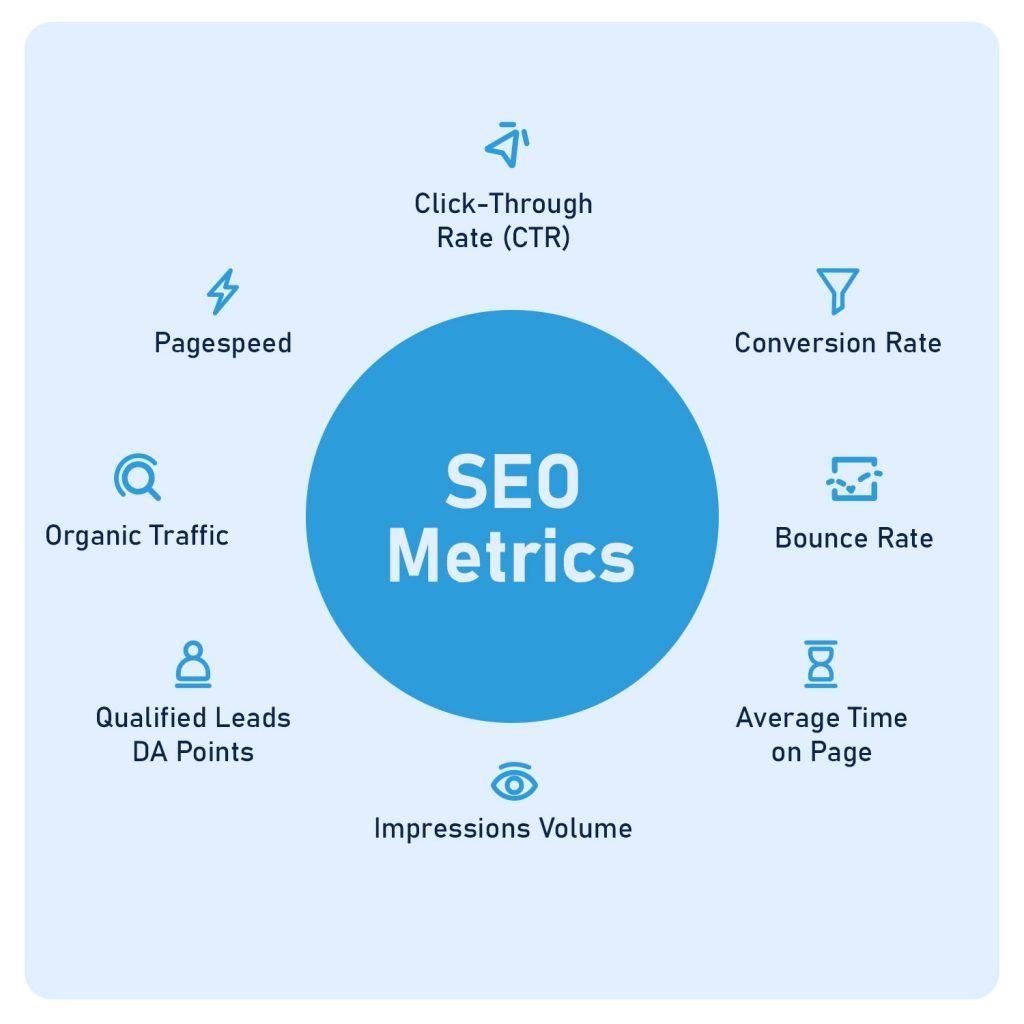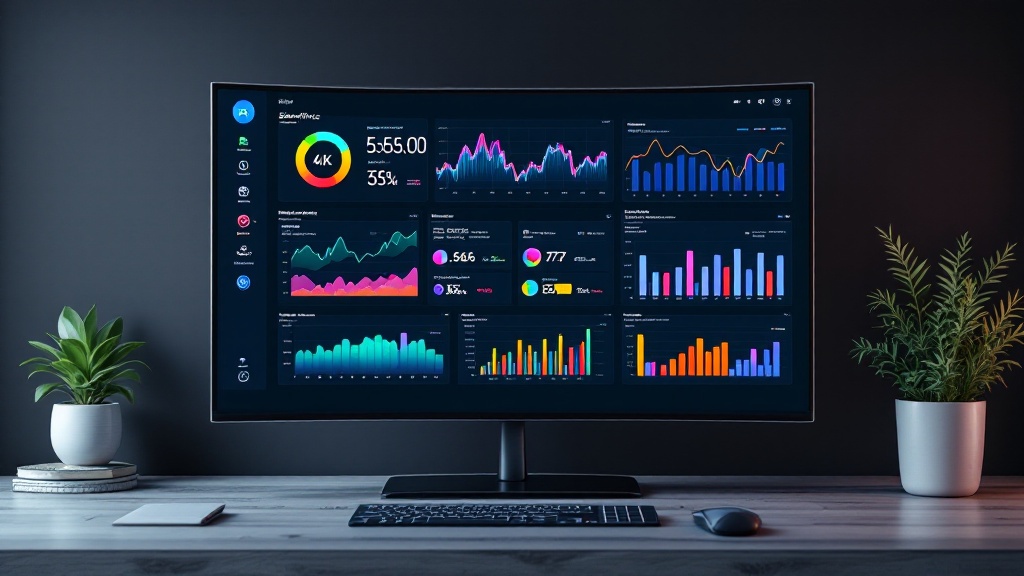Understanding SEO metrics is crucial for effective digital marketing. These metrics guide your strategy and measure success.
SEO metrics are vital for tracking and improving website performance. They provide insights into how well your site ranks on search engines. By analyzing these metrics, you can make informed decisions to boost visibility and traffic. The right metrics help identify strengths and weaknesses.
This ensures that your SEO efforts are targeted and effective. In this post, we will explore key SEO metrics. These metrics will help you optimize your website for better results. Whether you are new to SEO or looking to refine your strategy, understanding these metrics is essential. Let’s dive into the world of SEO metrics and discover how they can enhance your online presence.
Table of Contents
ToggleIntroduction To Seo Metrics
Understanding SEO metrics is crucial for anyone who wants to improve their website’s performance. These metrics help you track, measure, and understand how well your website is doing in search engines. By focusing on the right metrics, you can make informed decisions and optimize your strategies effectively.
Importance Of Seo
SEO or Search Engine Optimization is essential for driving organic traffic to your website. It helps your site appear in search results when users look for relevant information. Without proper SEO, your website might not reach its potential audience. This can affect your business growth and online visibility.
- Increases organic traffic
- Boosts online visibility
- Enhances user experience
Role Of Metrics In Seo
Metrics play a vital role in evaluating the success of your SEO efforts. They provide insights into various aspects of your website’s performance. This helps you identify areas of improvement and track progress over time.
| Metric | Description | Importance |
|---|---|---|
| Organic Traffic | The number of visitors coming from search engines | Indicates the effectiveness of your SEO |
| Keyword Rankings | Your position in search engine results for targeted keywords | Shows how well you are optimizing for specific terms |
| Backlinks | Links from other websites pointing to your site | Helps improve domain authority and search rankings |
By regularly monitoring these SEO metrics, you can ensure your website stays competitive. This helps you achieve better rankings and attract more visitors.
Traffic Metrics
Understanding traffic metrics is crucial for improving your website’s performance. These metrics help you understand where your visitors come from and how they interact with your site. By analyzing traffic metrics, you can enhance your SEO strategy and attract more visitors.
Organic Traffic
Organic traffic refers to visitors who find your website through search engines like Google. These users type keywords into search engines and click on your link in the search results. Organic traffic is valuable because it often consists of highly interested users.
To boost organic traffic, focus on the following:
- Optimize your content with relevant keywords.
- Create high-quality and engaging content.
- Ensure your website is mobile-friendly and fast.
- Build backlinks from reputable websites.
Track your organic traffic using tools like Google Analytics. Look at metrics such as:
| Metric | Description |
|---|---|
| Sessions | Total visits to your site. |
| Users | Unique visitors to your site. |
| Pageviews | Total pages viewed on your site. |
Referral Traffic
Referral traffic comes from visitors who find your site through other websites. These visitors click on a link from another site to reach yours. Referral traffic can be a significant source of new visitors.
To increase referral traffic, try the following:
- Get mentioned on popular blogs or news sites.
- Participate in forums and online communities.
- Share your content on social media platforms.
- Collaborate with influencers in your industry.
Monitor your referral traffic using Google Analytics. Key metrics to watch include:
| Metric | Description |
|---|---|
| Source | The website sending traffic to yours. |
| Sessions | Total visits from referral sources. |
| Conversion Rate | Percentage of referred visitors who convert. |
Engagement Metrics
Engagement metrics are vital for understanding how visitors interact with your website. These metrics help you gauge the quality of your content and the user experience. By focusing on engagement metrics, you can make informed decisions to improve your site’s performance and user satisfaction.
Bounce Rate
The bounce rate shows the percentage of visitors who leave your site after viewing only one page. A high bounce rate might indicate that your content is not engaging or relevant. To lower the bounce rate, ensure your content is valuable and your site is easy to navigate.
- Make sure your site loads quickly.
- Use engaging headlines and visuals.
- Provide clear calls to action.
Average Session Duration
The average session duration measures the time visitors spend on your site during a single session. Longer sessions usually mean that users find your content interesting and engaging. To increase session duration, create high-quality content and use internal links to guide visitors to other relevant pages.
- Offer comprehensive and informative content.
- Use multimedia like videos and infographics.
- Encourage user interaction with comments and feedback.
| Engagement Metric | Description | Tips for Improvement |
|---|---|---|
| Bounce Rate | Percentage of visitors leaving after one page | Improve content relevance and site navigation |
| Average Session Duration | Time spent on site per session | Create engaging and informative content |

Credit: agencyanalytics.com
Conversion Metrics
Conversion Metrics are essential for understanding the effectiveness of your SEO strategy. These metrics show how well your website converts visitors into customers or leads. Monitoring these metrics helps improve your website’s performance and achieve your business goals.
Conversion Rate
The conversion rate is the percentage of visitors who complete a desired action. This action could be making a purchase, filling out a form, or subscribing to a newsletter. A high conversion rate indicates that your website is effective in persuading visitors to take action.
To calculate the conversion rate, use this formula:
Conversion Rate = (Number of Conversions / Total Visitors) 100For example, if your website had 1000 visitors and 50 of them made a purchase, your conversion rate would be 5%. Improving this rate should be a top priority.
Goal Completions
Goal completions track the number of times visitors achieve specific objectives on your site. These goals can vary depending on your business. Common goals include:
- Making a purchase
- Filling out a contact form
- Signing up for a newsletter
- Downloading a resource
Setting up goals in your analytics tool helps you measure success. It also identifies areas that need improvement. Regularly review your goal completions to stay on track.
| Goal Type | Description |
|---|---|
| Purchase | Completing a transaction |
| Form Submission | Filling out and submitting a form |
| Newsletter Signup | Subscribing to a newsletter |
| Download | Downloading a file |
Tracking these goals provides valuable insights. It helps you understand user behavior and optimize your website for better performance.
Technical Seo Metrics
Technical SEO metrics are essential for ensuring your website runs smoothly. They help search engines crawl and index your site efficiently. This section will focus on two critical technical SEO metrics: Page Load Speed and Mobile-Friendliness.
Page Load Speed
Page load speed measures the time it takes for a page to load. A slow loading page can frustrate visitors. It can also hurt your search engine rankings. Improving page load speed can increase user satisfaction and boost your rankings.
| Metric | Ideal Value |
|---|---|
| First Contentful Paint (FCP) | < 2 seconds |
| Time to Interactive (TTI) | < 3.8 seconds |
| Speed Index | < 4.3 seconds |
Here are some tips to improve page load speed:
- Compress images
- Use a content delivery network (CDN)
- Minimize JavaScript and CSS files
- Leverage browser caching
Mobile-friendliness
Mobile-friendliness means your site works well on mobile devices. With more users browsing on mobile, this is crucial. A mobile-friendly site provides a better user experience and ranks higher on search engines.
Check your site’s mobile-friendliness with Google’s Mobile-Friendly Test. Ensure your site meets these criteria:
- Responsive design
- Readable text without zooming
- Properly spaced links
- Content fits the screen
Here are some ways to improve mobile-friendliness:
- Use a responsive theme
- Optimize for touch navigation
- Reduce pop-ups
- Improve page load speed on mobile
Content Performance Metrics
Evaluating the effectiveness of your content is crucial. Tracking Content Performance Metrics helps you understand what resonates with your audience. These metrics provide insights into how well your content is performing. They show which pages engage readers the most. They also reveal how often your content is shared. Here’s a closer look at some key metrics.
Top Performing Pages
Identifying your Top Performing Pages is essential. These pages attract the most traffic. They engage visitors and drive conversions. Use tools like Google Analytics to track page views. Analyze the average time spent on each page. Higher engagement signals valuable content.
Here’s a simple table to track your top pages:
| Page Title | Page Views | Average Time on Page |
|---|---|---|
| Home Page | 10,000 | 3:15 |
| Blog Post 1 | 8,500 | 4:10 |
| About Us | 7,200 | 2:45 |
By analyzing these metrics, you can identify which content resonates with your audience. This helps you create more of what they like.
Content Shares
Content Shares reflect how often your content is shared on social media. More shares mean higher reach. It also indicates your content’s value to readers. Use tools like BuzzSumo to track shares. Identify which platforms drive the most shares.
Here’s a simple list to track your content shares:
- Facebook: 500 shares
- Twitter: 300 shares
- LinkedIn: 200 shares
- Pinterest: 100 shares
Focus on creating shareable content. Use engaging headlines. Include eye-catching images. Write informative and valuable content. Encourage readers to share your content. This increases your reach and boosts your SEO.
Link Building Metrics
Link building metrics play a crucial role in SEO. They determine the strength and relevance of your website’s backlinks. Understanding these metrics helps you improve your site’s authority and search engine ranking. Below, we dive into two key link building metrics: Backlink Quality and Domain Authority.
Backlink Quality
Backlink quality is about the value of the links pointing to your site. Not all backlinks are created equal. High-quality backlinks come from reputable and relevant sources. These links boost your site’s credibility.
To assess backlink quality, consider the following factors:
- Relevance: Links from sites related to your niche.
- Authority: Links from high-authority sites.
- Anchor Text: The clickable text in a hyperlink.
Here is a simple table to understand these factors:
| Factor | Description |
|---|---|
| Relevance | Links from niche-related sites |
| Authority | Links from high-authority sites |
| Anchor Text | Clickable text in the hyperlink |
Domain Authority
Domain Authority (DA) is a score developed by Moz. It predicts how well a website will rank on search engine result pages (SERPs). DA scores range from 1 to 100. Higher scores indicate a greater ability to rank.
Several factors influence Domain Authority:
- Linking Root Domains: The number of unique domains linking to your site.
- Total Links: The total number of backlinks to your site.
- Quality of Links: Higher quality links lead to a higher DA.
Improving your Domain Authority involves acquiring high-quality backlinks and maintaining a healthy link profile.
Competitive Analysis Metrics
Understanding Competitive Analysis Metrics is vital for any SEO strategy. These metrics help you learn from your competitors and improve your own performance. By analyzing these metrics, you can identify gaps and opportunities in your SEO efforts.
Keyword Gap Analysis
Performing a Keyword Gap Analysis helps you discover keywords your competitors rank for, but you do not. This analysis provides insight into potential keywords you can target to increase your search visibility.
Here is a simple way to conduct a Keyword Gap Analysis:
- Identify your top competitors.
- Use tools like Ahrefs or SEMrush to compare keyword data.
- Find keywords where competitors rank higher than you.
- Analyze these keywords for relevance and search volume.
- Incorporate relevant keywords into your content strategy.
Competitor Traffic
Analyzing Competitor Traffic helps you understand where your competitors are getting their website visitors. This information can guide your own traffic acquisition strategies.
Consider the following steps to analyze competitor traffic:
- Use tools like SimilarWeb or Alexa.
- Identify traffic sources such as organic search, paid search, and social media.
- Evaluate the percentage of traffic from each source.
- Analyze the top-performing pages on competitor websites.
- Develop strategies to capture traffic from these sources.
Understanding these metrics can help you make informed decisions and enhance your SEO strategy.
Tools For Tracking Seo Metrics
Tracking SEO metrics is crucial for understanding your website’s performance. Using the right tools can make this task easier and more efficient. Below, we explore some of the best tools for tracking SEO metrics.
Google Analytics
Google Analytics is a powerful tool for tracking SEO metrics. It provides detailed insights into your website traffic. You can see how visitors find your site, which pages they visit, and how long they stay.
Some key features of Google Analytics include:
- Real-time data on site traffic
- Audience demographics and interests
- Behavior flow to see how users navigate your site
- Conversion tracking to measure goals and events
Google Analytics also allows you to create custom reports. These reports can focus on specific metrics that matter most to your business.
Seo Software Solutions
There are several SEO software solutions available. These tools offer comprehensive features for tracking and improving SEO metrics.
Some popular SEO software solutions include:
- Ahrefs: Known for its robust backlink analysis and keyword research tools.
- SEMrush: Offers a wide range of tools for keyword research, competitor analysis, and site audits.
- Moz: Provides helpful tools for tracking keyword rankings, site audits, and link building.
- Screaming Frog: A website crawler that helps identify SEO issues on your site.
These tools offer various features like:
| Tool | Key Features |
|---|---|
| Ahrefs | Backlink analysis, keyword research, rank tracking |
| SEMrush | Competitor analysis, keyword research, site audits |
| Moz | Keyword rankings, site audits, link building |
| Screaming Frog | Site crawler, SEO issue identification |
Using these tools can provide valuable insights into your website’s SEO performance. They help you identify areas for improvement and track your progress over time.

Credit: www.wordstream.com
Future Trends In Seo Metrics
The SEO landscape is constantly evolving, and keeping up with future trends is essential. With the rise of new technologies, SEO metrics are bound to change. Let’s explore some key future trends in SEO metrics.
Ai And Machine Learning
Artificial Intelligence (AI) and Machine Learning are transforming SEO. Search engines use AI to understand user intent better. This means that SEO metrics will adapt too.
- User behavior analysis: AI can track user behavior more accurately. Metrics will now focus on user engagement and interaction.
- Content relevance: Machine learning algorithms will assess content for relevance. Metrics like content quality score will gain importance.
As AI technology improves, expect more sophisticated metrics. These will provide deeper insights into user preferences and search intent.
Voice Search Impact
Voice Search is becoming more prevalent. It is changing the way people search online.
- Natural language processing: Voice searches use natural language. Metrics will measure how well content matches conversational queries.
- Answer accuracy: Voice assistants prioritize accurate answers. Metrics will track the accuracy and relevance of content.
Voice search will also influence keyword strategies. Long-tail keywords and question-based keywords will become more significant.
| Trend | Key Metric | Impact |
|---|---|---|
| AI and Machine Learning | User Engagement | Better user behavior tracking |
| Voice Search | Answer Accuracy | Improved content relevance |
Stay ahead by focusing on these future trends in SEO metrics. Adapt and evolve to maintain a competitive edge in the digital landscape. The future of digital marketing necessitates a shift towards personalized and user-centric approaches. In order to keep up with these changes, businesses will need to prioritize SEO metrics that reflect user engagement, such as time on page and bounce rates. Additionally, harnessing the power of AI and machine learning will be crucial for understanding and predicting consumer behavior in the ever-evolving digital marketplace. Furthermore, as ecommerce continues to dominate the retail landscape, it will be essential for businesses to focus on ecommerce metrics that drive conversion and sales, such as click-through rates and cart abandonment rates. By staying ahead of these future trends in SEO and essential ecommerce metrics, businesses can ensure they are well-equipped to meet the demands of the modern digital consumer and thrive in the competitive online marketplace.

Credit: www.seoreseller.com
How Do SEO Metrics Impact Search Engine Trends and Digital Marketing Success?
SEO metrics play a crucial role in shaping the future of digital marketing through search engine. By analyzing metrics like organic traffic, keyword rankings, and click-through rates, marketers can adapt their strategies to align with emerging search engine trends. This can lead to greater success in reaching target audiences and driving traffic.
What Role Do SEO Metrics Play in Predicting Search Engine Trends?
SEO metrics play a crucial role in predicting search engine trends digital marketing. By analyzing data such as keyword rankings, organic traffic, and user engagement, marketers can anticipate shifts in search behavior and adjust their strategies accordingly. Understanding these metrics is essential for staying ahead in the competitive digital landscape.
Frequently Asked Questions
What Are Seo Metrics?
SEO metrics are data points that measure the effectiveness of your SEO strategies. They help track performance, identify areas of improvement, and guide decisions to optimize your website for search engines.
Why Are Seo Metrics Important?
SEO metrics are important because they provide insights into your website’s performance. They help you understand what’s working, identify areas for improvement, and track progress towards your SEO goals.
Which Seo Metrics Should I Track?
Track metrics like organic traffic, keyword rankings, bounce rate, and conversion rates. These metrics provide a comprehensive view of your SEO performance.
How Can I Improve My Seo Metrics?
To improve SEO metrics, optimize your content, build quality backlinks, enhance user experience, and ensure mobile-friendliness. Regularly update your SEO strategy based on metric analysis.
Conclusion
Understanding SEO metrics is crucial for your online success. Track your progress regularly. Use these insights to improve your strategies. Focus on the most relevant metrics. Adjust your content based on data. Stay updated with the latest trends. This helps you stay competitive. It’s also important to not only focus on the quantitative metrics, but also to understand the qualitative aspects of SEO. Knowing the SEO basics such as keyword optimization, quality backlinks, and user experience can significantly impact your website’s performance. Utilize these fundamentals in conjunction with your data insights to ensure a well-rounded and effective SEO strategy. Remember, SEO is an ongoing process, so consistently monitoring and adjusting your approach is key to long-term success.
Remember, consistency is key. Keep analyzing and refining your approach. With effort and attention, you can enhance your SEO performance. Enjoy the benefits of better visibility and engagement. Always aim for steady improvement. Happy optimizing!








